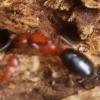Howdy y'all.
New around here. I am in the Fort Worth area of Texas, USA. I never really dived into ant keeping, mostly because of opportunity and time. Well, I tripped over a log slated for our burn pile that happened to have an established Camponotus sp. colony in it, so opportunity came a knocking and I answered. Basically I am doing this on a budget, so homemade is the way I went. The completed setup is at the bottom of the post. I figure the ants are Camponotus decipiens or Camponotus sayi.
When I first found the log I positively identified the queen scurrying away when a piece of the log broke off when I picked it up. Here she is.
Video of her.
Here is the broken piece I put in an aquarium on the left (was known to contain the queen) and the rest of the log in another aquarium on the right.
The very next day I found the ants moving much of their brood into a rusty lamp on the porch a few feet from the aquariums. I think it was all just too wet or having the hive split in two was freaking them out. I put some petroleum jelly on the rims of the aquariums to contain them then went about cutting open the old lamp base. I also confirmed the queen was still in her smaller piece of the log.
Here is the lamp and the brood in the base after I cut it open. Lots of angry workers swarmed out during the cutting, what are you going do though?
So after this I thought maybe I need to get something together the next day since they seemed ready to find someplace more permanent and homey. I didn't know what kind of stress levels these guys could take...
So I made a 2 in 1 foraging area (outland?) and formicarium out of some wood and a 20 gallon aquarium. I have lots of random crap like this along with tools to make random things.
Hers is the wood all carved up. The wood was confirmed to be not treated wood, no chemicals.
Here is the wood in the aquarium along with other angles of the setup. I rubbed some clay on the high parts of the wood just to have some color contrast between the chambers / tunnels and the rest of the wood.
As you can see, the wood was not fitted well. There is too big of a gap between it and the glass, allowing dirt and ants to get between the uncarved spots and the glass. Strike 1 on my rush job.
Here I have put in a heating pad (reptile under the tank heating pad) and a water dish. I don't have any test tubes at the moment but I will get some soon. The heating pad is under the right corner and comes up and onto the right side, heating that bottom right corner from the bottom and the side. Do y'all think this will give a good heating gradient? I also have cardboard in place to cover the viewing side of the formicarium so the colony can live in dark peace when I'm not being nosy.
I've also drilled two holes on the top right that just go straight down an inch or two, leading nowhere. These I figured I could put water in to moisten the right side a bit. Also, since there is more of a gap then I wanted I can drop water between the glass and wood also if that would do a better job in making a moisture gradient. My understanding is Camponotus sp. usually like it fairly dry so I'm not sure how much I should really be concerned with this.
I am using a good layer of petroleum jelly on the top inch and on the underside of the lip to contain them, does that seem sufficient? So far I've seen no one even attempt to cross the jelly when it is encountered.
Though the gap exists the silicone seems to have made a good enough seal on the sides and bottom to not allow them to go from the bottom of the wood to the soil and rocks underneath the soil. So hopefully there will be no secret nesting and I can keep tabs on their activity. This is my first real ant formicarium and I would like to view their nesting for pleasure and assurances that all is going well.
The outland is just river rocks with red clay compacted on top. You can dig up the clay around here after going a couple of inches past the top soil. I figured the clay will be good at mitigating any soil nesting and unwanted pests and bacterium. Maybe, idk, sounded good when I thought of it.
Well, here is the picture I'm sure most wanted to see. The ants in their new home. The queen is even front and center!
There are at least 70 ants, a mix of minors and majors. There is at least that many, if not more, eggs, larva and pupae. I feel I have made a common mistake here for first timers. There is a lot of unused space here and I'm not sure if it going to be a problem as time goes on. Strike 2! That wood is roughly 10 inches by 11 inches (25 cm x 28 cm), I didn't think that was super big. There being space between the uncarved wood and the glass doesn't help obviously. I just didn't know what I was going really end up with once I carefully dissected that log. Turns out it is a well established colony but most of the wood was empty or filled with termites, not the ant colony. I did not see the termite queen in case someone was wondering. Not really sure what that would look like anyways. The termites and their log went back to the burn pile, sorry, not sorry.
That was all yesterday. Most of the ants moved out last night. The queen, the work force, and brood that were in the bottom left corner of the nest are gone.
I found they had moved into the hydrometer sitting on top of their wooden formicarium...
So what did they find so appealing about that location? That meter is sitting between the holes I used to moisten the wood so the very localized air humidity may have been high but I'm sure that side of the formicarium would be very similar. It certainly isn't straight up wet inside the meter and the temperature would be the same as most of the outland and formicarium. My best guess is they just really liked it being a tighter space, felt more protected. So my formicarium sucks because I made all the chambers way to big, that is what I think. :-P
They can't all fit in there, some of the colony was left behind. And that space can't hold the majority of the colony when growth starts to happen. I am very curious what they will decide to do then...
Any insights out there in internet land?
So what do we think? I plan on taking lessons learned and turning a 10 gallon tank into a straight formicarium, no outland included. I'll take my time and fit everything well and show a clean presentation. I'll have it so I can open partial sections at a time to fit the colony size. Now that these guys are settled I don't feel rushed and can just slowly work on the next formicarium over weeks or months instead of all in a day. I really enjoyed this mini project and I know I will either be getting another colony in the future (next year?) or my first colony will need a new home from growth or simply the formicarium becoming unsuitable from bad design or filth.
Do these guys usually have repletes and are they recognizable? One last thing, does the queen abdomen on these guys always look that... not swollen... or do you think she is just in a recuperation period and she will start to swell up when she goes into her next egg laying cycle? I am thinking this queen is about 2 years old considering the numbers and few majors. I understand this genus grows slow but we do get a many more warm days in Texas then a lot of temperate places with carpenter ants. What do y'all think?
Please let me know what I should do to better the chances of success of this first formicarium and how I could improve on the next one. I really appreciate y'all that decided to read all this just to help me out and encourage!
Laters for now!

![]()
![]()

